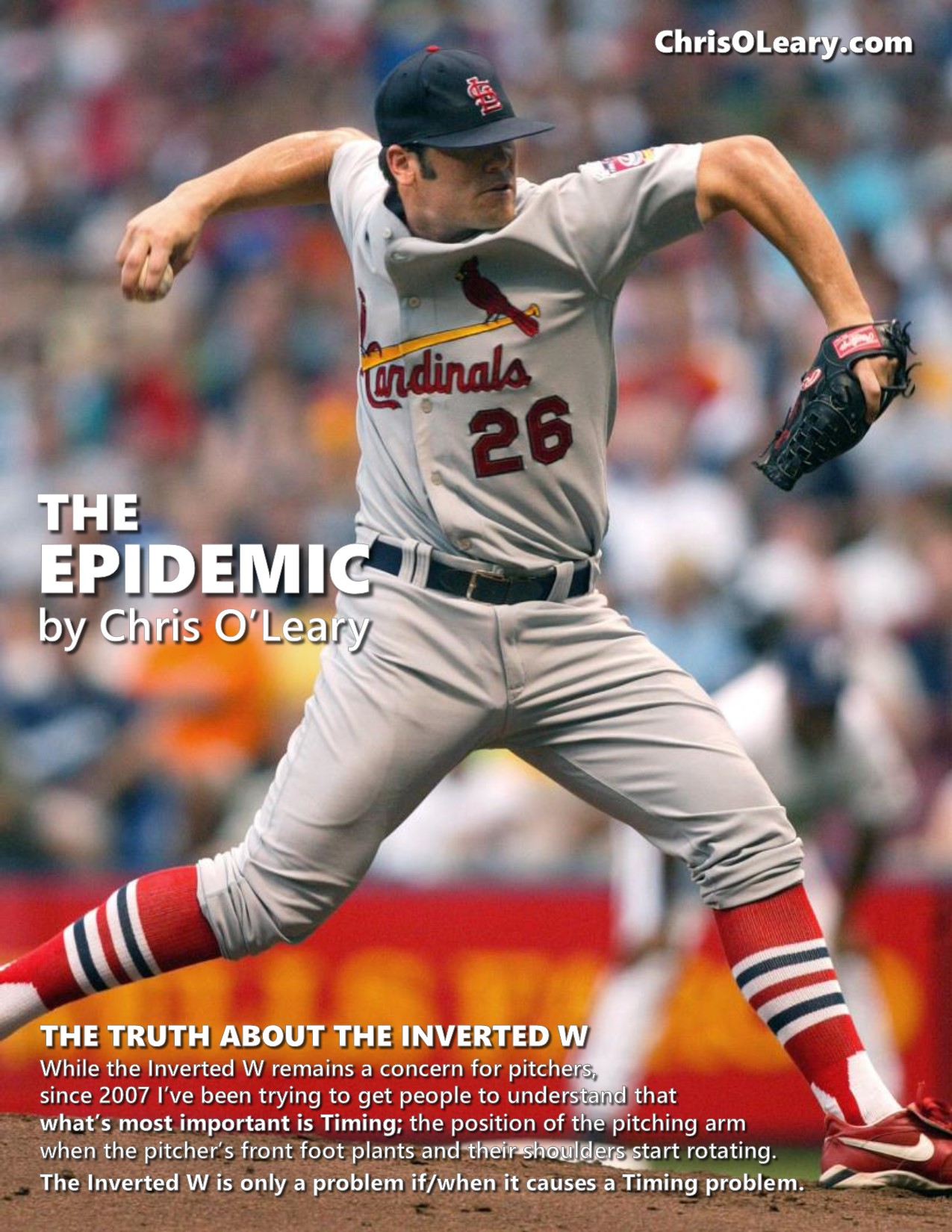| ChrisOLeary.com |
| ChrisOLeary.com > BUY > Pitching > Epidemic > Inverted W |
|
Created
2013.8.21
And, before you ask, when I first saw the Inverted W, I also called it The M. The problem is the Inverted W, and the other inverted arm actions, are making a resurgence as a result of Driveline's advocacy of the... I find that to be unconscionable, given that that's the same movement pattern that got Kyle Boddy's own arm. 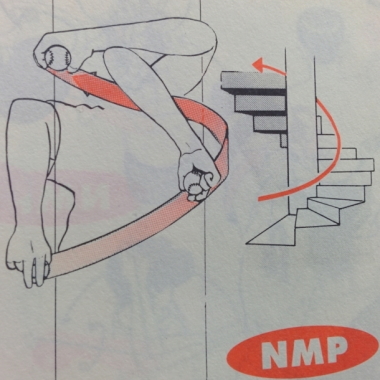
I know that, because I helped Kyle fix the problem back in the day. If you don't know who to believe, when it comes to the Inverted W, I'd refer you to what Eric Cressey, now of the New York Yankees, said about the Inverted W way back in 2012... The Inverted W theory is incredibly sound; Chris O'Leary did a tremendous job of making his case – and we certainly work to coach throwers out of this flaw... For the latest on the Inverted W, including my comments on what Jeff Passan says about the Inverted W in The Arm, see... And, if you doubt what I said about the Inverted W and/or when, you can verify it using The Wayback Machine. Inverted WMy statements about the Inverted w are based on my experience predicting injuries to pitchers given the presence of these arm actions, combined with the results of recent studies that have found that pitchers who employ the Inverted W and the other inverted arm actions... ...and have the Timing problem that is so often the result — and that is the root cause of the problem — are at a significantly higher risk of experiencing elbow and shoulder problems. Since 2006The Inverted W is something I've been expressing concern, and writing, about for years, because of Mark Prior's pitching mechanics and his injury problems. Regarding the Inverted W and Mark Prior, and as I first said in 2007... In Frame 28, Mark Prior is at a position that I call the Inverted W (or simply The M). Notice how his PAS elbow is both above and behind his shoulders and his PAS forearm is hanging down nearly vertically beneath it. This position isn't damaging in and of itself. However, by coming to this position, Mark Prior is ensuring that his pitching arm will not be in the proper position at the moment his shoulders start to turn. As with pitchers with other timing problems like rushing, because his pitching arm is so late, he will dramatically increase the stress on both his elbow and shoulder. I then said it again, on a third party podcast, in 2010.... What the not so durable guys do is they take their elbows back but they also take them up. Now, that's actually painful to do, but it's not that bad in and of itself. The problem is that when you take the elbows back and up, you CAN end up with a Timing problem. DefinitionThe Inverted W is defined as the pitcher...
Biomechanically speaking, that means bilateral hyperabduction and minimal external rotation, or worse prolonged internal rotation, of both arms into Foot Plant. 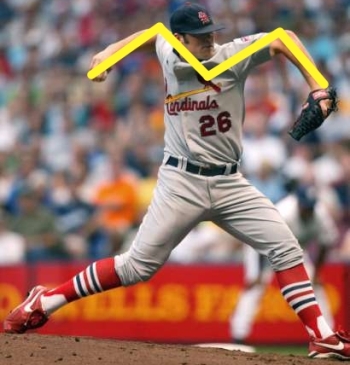
The Inverted WThat can be problematic and increase the pitcher's risk of elbow and shoulder problems if it hurts their Timing; if their pitching arm isn't up and in the Ready Position when their front foot plants and their shoulders start to rotate. 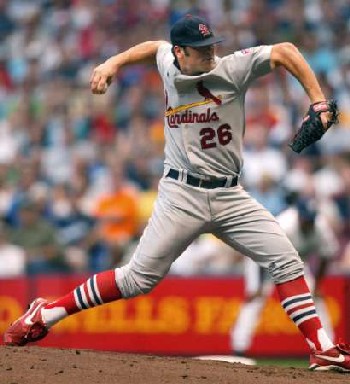
Anthony ReyesIn the pictures above of Anthony Reyes, the primary problem isn't the height of his elbows. Rather, the primary problem is that, because his elbows are still high, his forearms are at best flat, and actually slightly internally rotated, when he's at Foot Plant. That will significantly increase the stress placed on his elbow and shoulder. That is exactly what I said in a 2010 interview about Stephen Strasburg and the Inverted W... What the not so durable guys do is they take their elbows back but they also take them up. Now, that's actually painful to do, but it's not that bad in and of itself. The problem is that when you take the elbows back and up, you can end up with a timing problem. ...and it's what a study of the Inverted W found. ASMIDespite the studies of the Inverted W and Timing that are starting to come out, I still get considerable pushback on the idea that the Inverted W is problematic. That is why I was interested by what an ASMI epidemiologist recently said about the Inverted W... The Inverted W is something that we look for during our biomechanical evaluations here at ASMI. It's essentially a combination of late external rotation and high shoulder abduction at the moment of foot contact during a pitcher's delivery. Both of these issues have been demonstrated to lead to problems that can result in injuries requiring surgery. Low external rotation at foot contact (what we call a "late arm") results in higher stress on the elbow. The ideal angle of shoulder abduction is 90°, because the bones and the soft tissues supporting the joint are able to move the most freely and most efficiently. When the arm is raised higher, the soft tissues in the shoulder joint become impinged, or pinched against the shoulder socket, and can cause injury. So when you add these two things together in the Inverted W, a pitcher can really get into trouble. I view the fact that ASMI incorporates the Inverted W into their evaluative criteria to be a huge advance and validation for the idea that the Inverted W and the other arm actions are problematic because they often cause Timing problems. The Problem: TimingThe Inverted W, and many other problematic pitching arm actions, often leads to a problem called Flat Arm Syndrome, which is another, easier-to-visualize way of describing the Timing problem that is the root cause of the injury problems of a number of pitchers, including... As I explained in late 2007 in my analysis of Mark Prior's pitching mechanics, and more recently in my analysis of Stephen Strasburg's pitching mechanics... The Inverted W isn't (necessarily) a problem in and of itself. Rather, the Inverted W contributes to injuries in pitchers by creating a timing problem, and timing problems are what tend to hurt pitchers' arms. The Inverted W increases the likelihood that a pitcher's arm will not be in the proper position when their front foot plants and their shoulders start to rotate. That will increase the load on the elbow and the shoulder, providing a short-term velocity boost but, in the long run, significantly increasing the risk of injury to the pitching arm. 
Anthony ReyesIn the picture above of Anthony Reyes, the primary problem isn't the height of his elbows. Rather, the problem is that Anthony Reyes' forearms are pointing downward at the moment his front foot plants and his shoulders start rotating. That will cause his pitching arm to externally rotate (flip over backwards) with much more force than his body can handle. 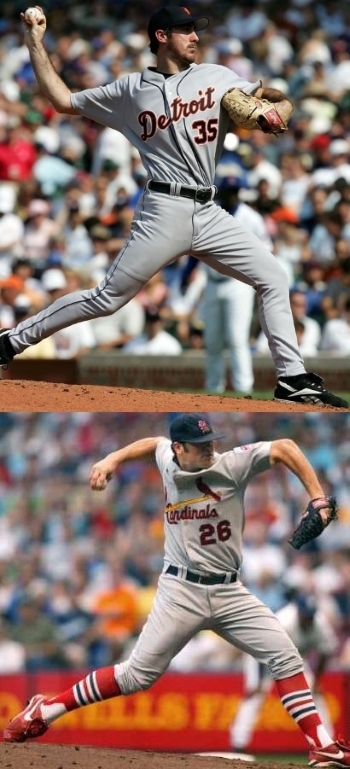
Justin Verlander and Anthony Reyes c. 2006If you compare the arm actions of Justin Verlander and Anthony Reyes, it's obvious why Justin Verlander is still pitching and Anthony Reyes isn't. As I discuss at length in my piece on Flat Arm Syndrome, at foot plant Justin Verlander's pitching arm is UP while Anthony Reyes' pitching arm is at best FLAT. Anthony Reyes' pitching mechanics — his Inverted W and resulting Timing problem — are why he only pitched in the major leagues for a few years before breaking down for good. NymanThe idea that the Inverted W is problematic is controversial. Its originator of the Inverted W, an engineer named Paul Nyman — surprise, surprise — says I'm wrong. I have addressed some of the objections to the theory first in this piece... ...and in a couple of others as well... What's more, a number of studies have been completed that are relevant to the Inverted W in particular and Timing problems in general. I discuss them on my piece on The Science Behind The Epidemic. |
| about | contact | copyright | sitemap | liability policy |

